Understanding variance in poker is one of the key fundamentals to becoming a long-term profitable player.
It can be cruel or kind, but one thing it’s not is unavoidable.
We will explain exactly what variance is and how it works. We’ll walk you through real-world scenarios of how it occurs within the game and strategies that you can implement to limit its impact.
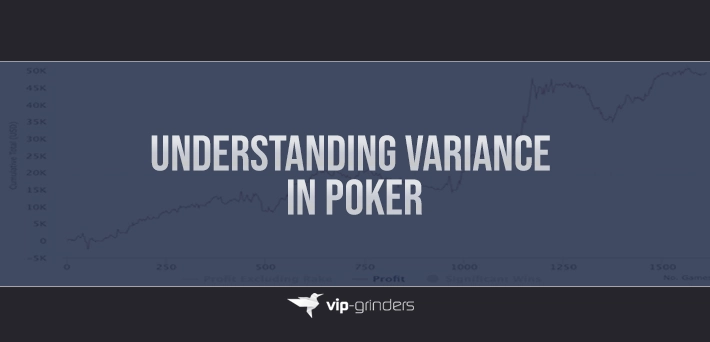
What is Variance in Poker?
Variance is the difference between expected and actual results over a short period of time.
Basically, it’s when something happens that was statistically but not mathematically unlikely.
Let’s run through an example.
If you’re dealt pocket Aces and go all in pre-flop, statistically, you will win 85% of the time against a random range of hands. This means that every time you have Aces pre-flop, you go into the hand as a big favorite.

However, we know that some of the time, you will lose. So, you’re getting your money in ahead, and when you lose, this is down to variance. In fact, you could lose multiple times in a row.
Again, statistically, it’s unlikely, but mathematically, it’s possible. The reason? Variance.
Let’s expand on this to see how variance affects some of the strongest starting hands in Texas Holdem when playing against a random range.
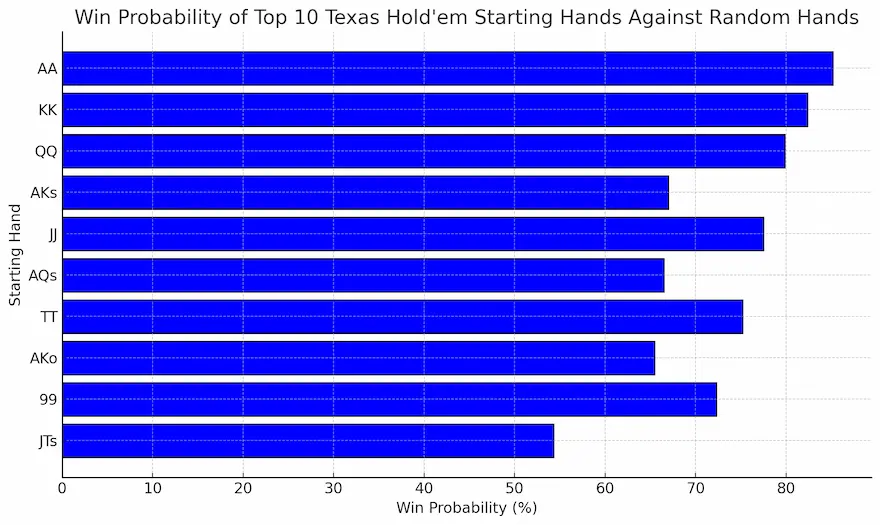
As you can see, the stronger the hand, the more chance you have of winning.
To balance variance, you need volume. You could play Aces five times in a row and lose all five. But if you played it 1,000 times in a row, the variance would decrease, and your win percentage would get much closer to the 85% chance of winning.
What Causes Variance in Poker?
Luck is the catalyst for variance in poker.
We can take a simple coin flip to explain this better.
A coin flip always has a 50/50 chance of landing on heads or tails. However, we know that you could easily flip five heads in a row, and by doing so, you would be unlucky in getting these results.
If we flip the coin 1,000 times, we’ll get much closer to 50% heads and 50% tails. Like the AA win percentage above, the larger the sample, the lesser the variance.
Short Term vs Long Term Variance
Everyone endures short and long-term variance at some point when playing poker. It’s part of the game, and you need to be able to deal with it.
In our guide on How to Make $1,000 a Month Playing Online Poker, we profiled one of the best small stakes players in the world,
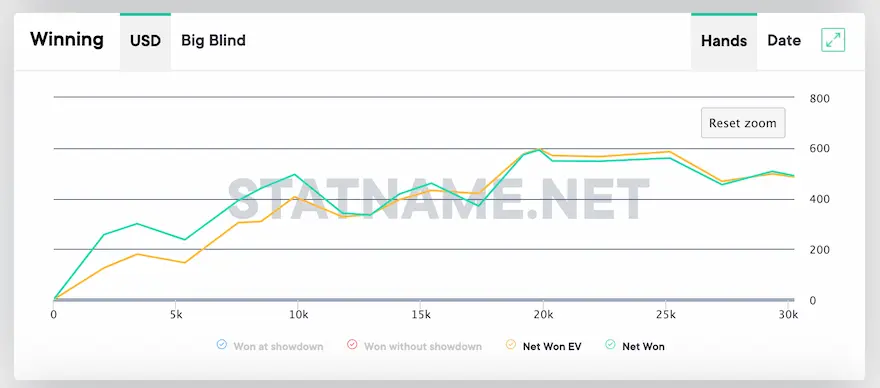
.
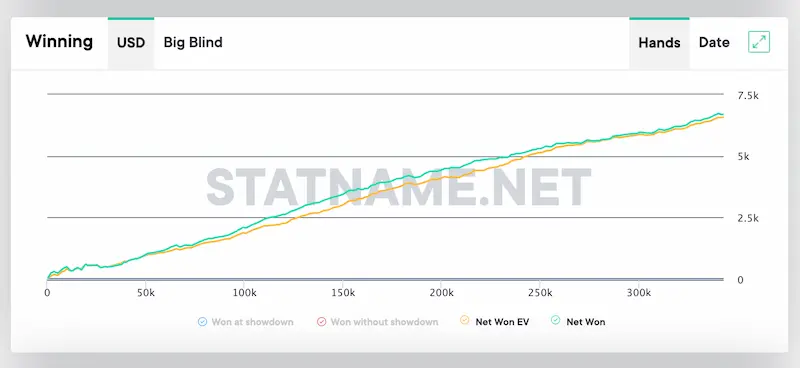
One of their strengths is their consistency, and to look at their graph over the course of 2024, you would be forgiven for thinking that variance doesn’t play its part. But you would be wrong.
The graph above shows the first 30,000 hands or so that they played in 2024. The green line is the actual amount they won, and the yellow line is the adjusted winnings based on expected value (EV).
EV is a term used in poker that indicates whether the variance is on the player’s side — often called running good or bad.
For the first 12,000 hands, MeTaJIJIucT was up on his expected winnings. Variance was favorable, and they were running good. Following that, variance catches up, the amount of money won flat lines, and there were more days than not where variance was unkind.
If you were to look at the first graph (long term), you would think that life is good for MeTaJIJIucT, and to be fair, it is. But if you break it down into bite-sized pieces, variance plays a part in the short term, even for the best players in the world.
Types of Variance in Different Poker Formats
Variance in poker comes in all shapes and sizes, affecting players differently due to skill and luck.
An area that many players new to the game overlook is the type of games and poker variants they are playing. This has a huge impact on how variance works, and you must be able to absorb this if you want to be profitable in playing poker.
Cash Games vs. Tournaments
Cash games are historically the least affected by variance. Here’s why:
- Consistent payout structure – Each hand is played independently, allowing players to accumulate smaller wins more frequently over a longer period of time.
- Ability to leave anytime – Players can leave their seat anytime and lock in profits. This lowers risk and minimizes variance.
- Deeper stack play – Cash games allow deeper stacks as blinds are fixed with no increases throughout. Deeper stacks allow players to demonstrate greater skill levels with greater control over their decisions.
- Lower frequency of all-ins – Players can be more conservative and avoid all-in situations. Controlling pots due to deeper stacks allows players not to go all-in as often and, thus, lower variance.
Tournament poker is the opposite of all that. You’re playing for your life at some point in every tournament, so inevitably, you will see a much higher variance.
The tradeoff is that you can win life-changing sums of money from a single tournament, whereas cash games are more of a slow and steady grind.
Before we jump into a real-world example, scroll back up and look at how consistent and linear MeTaJIJIucT’s graph is above. We know there have been long periods of break even and small loss stretches, but zoomed out, it’s about as good as it gets.
For comparison, we’ve included the 2024 graph of one of the best tournament players in the world, Rams85.
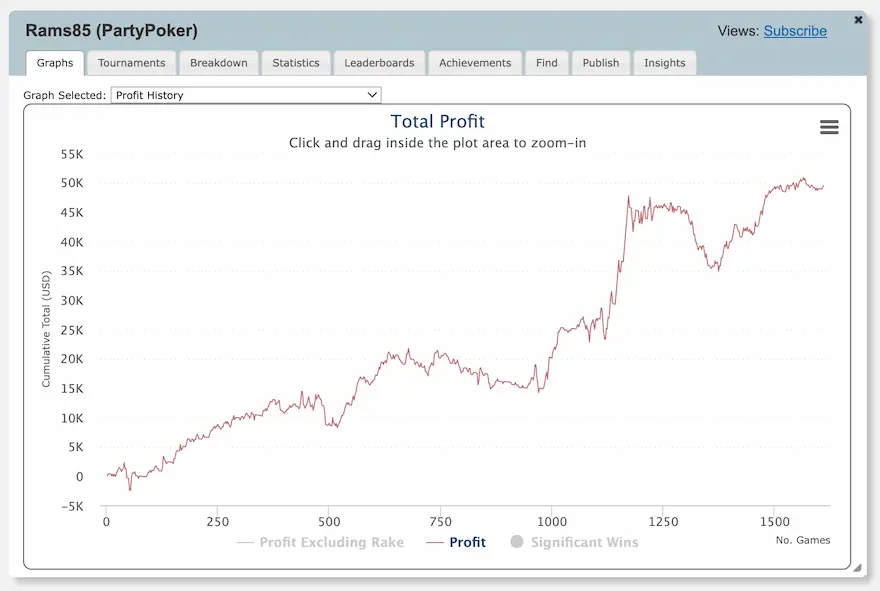
Initially, you’d see this and say it’s a pretty sweet-looking graph. They’ve made almost $50,000 profit in 2024, averaging $30.72 for each tournament they’ve entered (total of 1,609).
But what happens if we zoom in a little?
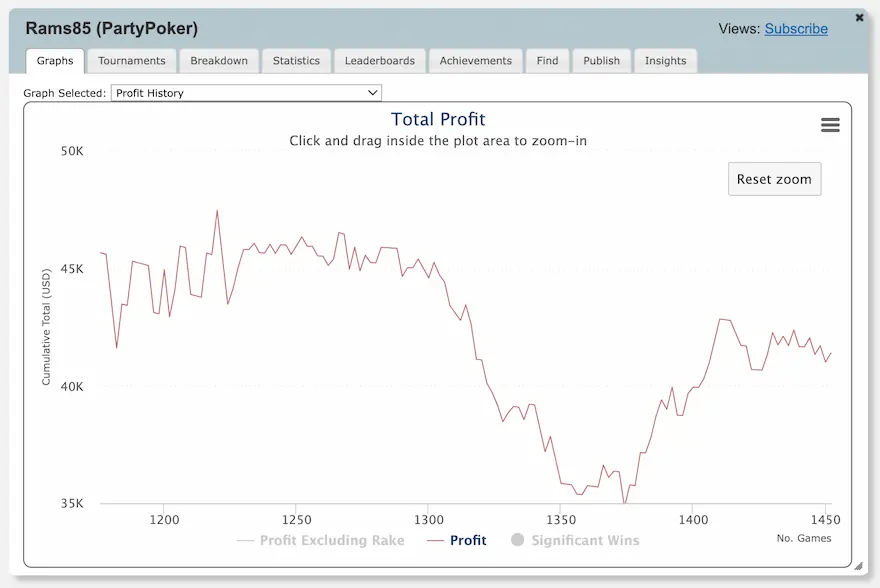
This is Rams85’s graph over the course of around 330 games. They are down around $5,000, hitting a low of over $10,000.
We know they average 11.7 games per day for 2024, so this is essentially a month’s worth of play. That’s a huge number of games and a significant loss to boot.
Bear in mind, this is one of the best tournament players in the world here and they’ve just lost a good chunk of cash over a significant sample of games.
Then, we jump back and ask why.
Well, it could be that they weren’t playing well enough, but more likely, this is good old variance in full force.
You can be the best player in the world, but at some point, variance will beat you down. It’s how you respond that separates the best from the broke, and you can see from the first graph that they’ve come out the other side and are now on a sizeable upswing as variance starts to level and equal itself out.
No Limit vs. Limit Poker
Variance with no limit is much higher than limit poker.
With the former, you can lose your stack in any given hand. As the name suggests, there are no limits on bet sizing, which means the average pot sizes are much higher.
If you played the same stakes for limit poker, average pot sizes are much smaller. Since betting is capped in relation to the big blind and pot sizes, it’s hard to get all the chips in the middle for variance to take effect.
Managing Variance in Poker
We know that variance comes down to luck, for the most part. It’s often out of our control how it will impact our game and our bottom line.
Here are a few processes you can implement to best manage variance when playing poker.
Bankroll Management
A sufficient bankroll will allow you to ride the waves when variance is not on your side. Bankroll management is where you have enough funds to cover the stakes you’re playing, providing multiple buy-ins and preventing you from going broke.
For example, if you’re playing $20NL with a $100 bankroll, you’ve only got five 100bb stacks to play with.
A scenario could occur where you get your money in ahead and lose each hand, resulting in you going broke.
If your bankroll was $600 for 20NL, this then provides you with 30 buy-ins for this level. If you’ve lost five times when you’ve got the money in as a favorite, and you lose, this is now only a small percentage of your bankroll, and you can continue playing to allow the variance to level out.
Here are the buy-ins you need depending on the stakes you are playing for cash games.
| Stakes | Recommended Buy-ins | Recommended Bankroll ($) |
| 5NL ($0.02/$0.05) | 30 | 150 |
| 10NL ($0.05/$0.10) | 30 | 300 |
| 25NL ($0.10/$0.25) | 40 | 1000 |
| 50NL ($0.25/$0.50) | 40 | 2000 |
| 100NL ($0.50/$1) | 50 | 5000 |
| 200NL ($1/$2) | 50 | 10000 |
You’ll notice that as the stakes increase, the number of recommended buy-ins will increase. This is because games are tougher, and the swings can be more intense, meaning you need a bigger cushion to play at those stakes comfortably.
Tournaments require a deeper bankroll due to variance playing a much bigger part. Here’s a breakdown of what you need for your poker strategy.
| Tournament Buy-in | Recommended Buy-ins | Recommended Bankroll ($) |
| $1 | 100 | 100 |
| $5 | 100 | 500 |
| $10 | 150 | 1500 |
| $20 | 150 | 3000 |
| $50 | 200 | 10000 |
| $100 | 200 | 20000 |
| $200 | 300 | 60000 |
Discipline and Emotional Control
When you lose a hand that you’re a favorite to win, it’s called a “bad beat.” It’s one of the most frustrating parts of the game, but it’s an important factor to control.
The best in the world remove themselves from the result of the hand and instead determine the process as a win if they’ve got their money in ahead. After this, there is nothing else they can control.
You need to avoid emotional attachment to the money side and instead invest in the process. If you only look at the bottom line, it can cause you to tilt and play hands that you shouldn’t, chasing losses in the process.
If you feel like emotions are running high, then it’s time to take a break. This might be hours or days, but only return when you remove the emotional attachment of losses due to variance.
Long-Term Mindset
Everyone will go through periods of losing money at poker. We spoke about one of the best tournament players in the world with Rams85 and highlighted how they went on a 300+ game losing streak lasting over a month.
However, if you look at their graph for the year, they’ve won almost $50,000, which is highly impressive at these stakes.
A losing month will break many players, but what sets Rams85 apart is that they just kept going, making +EV plays and knowing that variance would eventually balance itself out, which it has.
Don’t Be Results Orientated
Don’t dwell on the result of the hand. Of course, you want to win, but it’s impossible for every hand, thanks to variance.
Sometimes, you get the money in way ahead of a massive fish at the table and lose. The flip side is that you will have sessions where you’re in as a massive underdog and bank huge winnings sessions.
You must focus on +EV plays, ensuring that your process is on point to win long-term once variance balances itself out.
Analyze your play and use EV graphs to see how you’re running. If you’re winning when you shouldn’t, you could have flaws in your strategy that you must address.
The flip side is that you need to be patient if you’re losing when you should be up. You’re getting your money in ahead more often than not, and you’re down thanks to a process you cannot control. Variance.
How to Reduce the Effects of Variance in Poker
One of the easiest ways to reduce variance in poker and balance out those inevitable downswings is by playing at sites with a rakeback deal.
Rake is the price of poker, and all cash games and tournaments will have a rake structure. A rakeback deal is where the poker room gives you a percentage of your cumulative rake back.
The best poker room for this right now is GGPoker.
If you sign up for a new account today, you can access a 60% rakeback deal and a $600 welcome bonus at GGPoker.
To put that into some monetary context, we estimated that MeTaJIJIucT, mentioned in our examples above, could earn up to $400 a month on rakeback alone based on their volume at low-stakes 10NL cash games.
If you’re playing without a rakeback deal, you’re leaving money on the table and increasing the effects of variance on your bottom line.
Final Thoughts
Variance is one of the biggest factors when playing poker. You must understand that it’s part of the game, and even though you’re statistically a favorite to win a hand unless your opponent is drawing dead, you will lose some of the time.
Controlling variance in poker is a skill, and the best players in the world do not let it affect their game. In fact, many embrace it, realizing that it’s an important part of encouraging poor players to keep depositing.






















